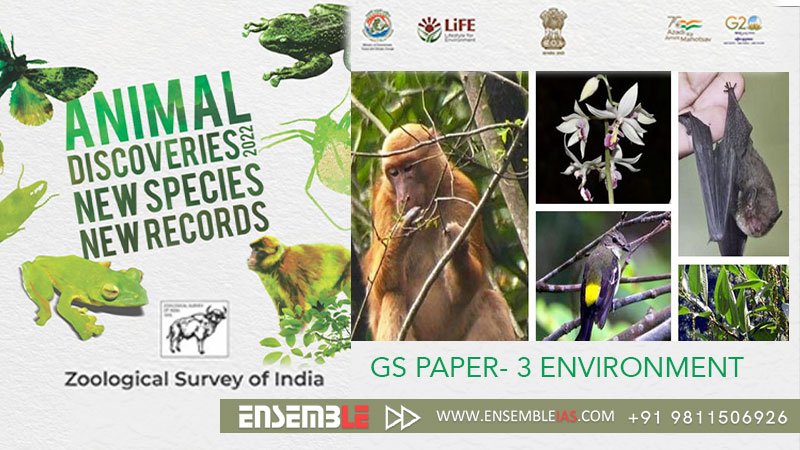Animal Discoveries
In 2022, India added 664 new animal species to its faunal record. They include 197 new records and 467 new species (species discovered for the first time in India).

The primary fauna species discovered include 28 new species and eight new records of fish, 30 new species and two new records of reptiles, two new records of birds, six new species and one new record of amphibians, three new species and one new record of mammals, and two new records of birds.
The link to join the course : Online Courses
Two species of bats from Meghalaya, Miniopterus phillipsi, a long-fingered bat, and Glischropus meghalayanus, a bat that lives in bamboo, are among the newly discovered mammals.
A new monkey species known as the Sela macaque (Macaca selai) was found in western and central Arunachal Pradesh and was given that name in honor of the Sela Pass.
Among the new records is Macaca leucogenys, a white-cheeked macaque originally discovered in Modog, southeast Tibet, and first seen in India in West Siang, Arunachal Pradesh, in 2022. The list also includes the yellow-rumped flycatcher, Ficedula zanthopygia, which was discovered last year on Narcondam Island in the Andaman archipelago. Formerly, this flycatcher was only known from Mongolia, Transbaikal, southern China, Korea, and western Japan.
The majority of new discoveries in 2022 came from Kerala. Kerala contributed up to 82 new animal species to science and 15 new records, making up 14.6% of all new species and records. Karnataka came in second with 64 new species and 24 new records, making up 13.2% of the total. 71 new discoveries and 13 new records were made in Tamil Nadu, making up 12.6% of all new discoveries and new records nationwide.
Plant Discoveries
339 new taxa that were added to the Indian flora in 2022 are listed in Plant Discoveries 2022.
37% of the newly discovered organisms are seed plants, 29% are fungus, 16% are lichen, 8% are algae, 6% are bryophytes, 3% are microorganisms, and the last 1% are pteridophytes. The greatest number of discoveries were made by seed plants, 73% of which came from dicotyledons and 27% from monocotyledons. The western Himalayas accounted for about 21% of all discoveries, and the Western Ghats for 16%.
Nandadevia Pusalkar, a genus widespread throughout the foothills and warm outer valleys of the Uttarakhand Himalayas, and Nilgiriella Pusalkar, an endemic to the southern Western Ghats of India and scattered in Karnataka, Kerala, and Tamil Nadu, are two of the new plant genus that have been found. Calanthe lamellosa, a species of orchid previously only known from China and Burma, was discovered for the first time in India in the Japfu mountain range in Kohima, Nagaland.
Best Online Coaching for Civil Service_IAS_ UPSC_IFS_IPS, Free Study Material ENSEMBLE IAS ACADEMY
Call +91 98115 06926
Visit us:- https://ensembleias.com/
Online Store: https://online.ensemble.net.in/
Email: ensembleias@gmail.com
#animaldiscoveries #newspecies #newrecords2023 #GSPaper3 #environment #GSPaper3 #Social_Issues #economy #civilservicesstudy #ensembleiasacademy #geographyoptional #k_siddharthasir #ias #civilservices #upsc_motivation #upsc_aspirants #upsc_exam #trendsingeography #trendofquestions #geographytrends #civilservicesstudy #ensembleiasacademy #geographyoptional #k_siddharthasir #ias #civilservices #upsc_motivation #upsc_aspirants #upsc_exam #strategicthinker




